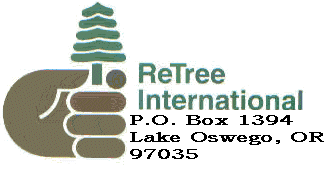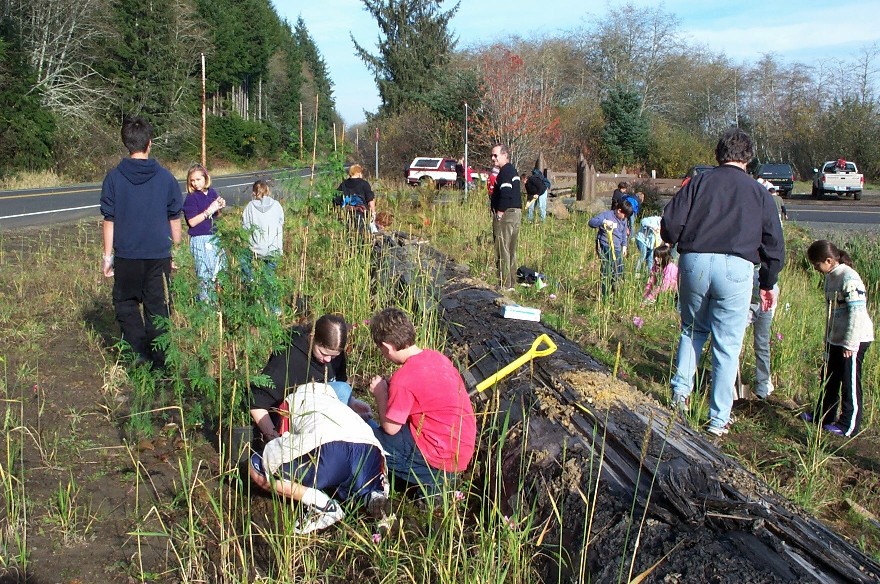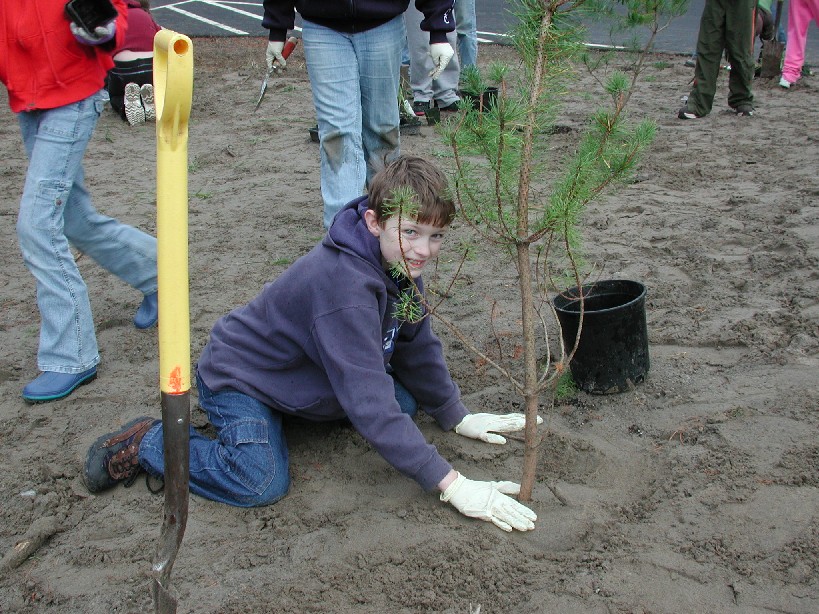
"We are now at the end of our voyage...to discover a passage to the Pacific Ocean."
November 16, 1805
The day was filled with wind, rain, sun, and rainbows- a perfect day for tree planting. The second year of planting at the Lewis and Clark National Historical Park has been completed. The event took place October 28, just a couple weeks before the 200th anniversary of the explorers' arrival to the Pacific Ocean. This year we planted the area along the Sunset Beach trailhead of the Fort-to-Sea Trail. And again this year 5th and 6th grade students from Lewis and Clark Elementary and Warrenton Grade Schools participated in the project, planting about 1650 native trees, shrubs, and dunegrass plants. Special thanks go out to Tom Wilson of Lewis and Clark Elementary, and Linda Bergerson of Warrenton, the two teachers who again this year organized the classes at their schools. The funding for this project continues to be made possible by a generous grant from Weyerhaueser.

Students putting plants into the ground.
In his book Trees For Tomorrow, ReTree International founder Frank Lockyear referred to the Lewis & Clark Bicentennial Celebration by saying, “…I might be around to take part in it. If so, my main contribution to the shindig will be to have a huge tree planting.”
ReTree has honored Frank's dream both on November 12, 2004, and now on October 28 of 2005 by holding tree plantings at Fort Clatsop's Netul Landing and at Sunset Beach along the Fort-to-Sea Trail. Almost 2200 native trees and shrubs were planted by 5th and 6th grade students from Lewis and Clark Elementary School and Warrenton Grade School over the last two years. Included in the programs was a brief environmental education presentation put on by the park staff which focused on subjects submitted by the students prior to the plant, relating to planting trees, local natural resource issues, and the Lewis and Clark expedition. Nancy Eid, one of the Park's resource managers, reminded the students of the vegetation that Lewis and Clark would have seen and written about nearly two centuries ago. “Those are the very shrubs and trees that you’re going to be planting today.” The plants also gave the students an opportunity to participate in a useful community service learning project. We think that Frank would have been very happy to see us take part in the "shindig".
This year's planting coincides with the Bicentennial festivities planned for the Park. Events are scheduled over the weekend of November 11-14th with the official commemoration taking place on the 14th at the Sunset Beach trailhead. This area has changed dramatically since the arrival of the explorers. Since construction of the south jetty about 75 years ago sand has been accumulating along the beach. It was suspected that this trailhead was at water's edge, now a quarter mile away, 200 years ago. A lot of this year's planting consisted of native dunegrass. It's hoped that establishing this plant will help stem erosion in the area.
The first year's plantings took place at Netul Landing just two days after the 199th anniversary of Lewis and Clark's arrival at the Pacific Ocean. The young people's efforts helped restore some of the newly acquired land to a more natural state as the Memorial began the process of transforming into the new Lewis and Clark National Historical Park. Also on November 12, the dedication ceremony for the newly created Lewis and Clark National Historical Park took place following President Bush's October signing of the legislation. More information on the Lewis and Clark Bicentennial is available at www.lewisand clark200.org. Information on Fort Clatsop can be found at www.nps.gov/focl/index.htm.

 We'd like to thank Weyerhaueser for their generous grant which helped to fund this project. In 2004 the Neahkahnie Lion's and Leo's Club from Rockaway Beach volunteered to help and ended up taking on the planting of some of the larger trees in some of the rockiest soil. We also asked nurseries in northwest Oregon to contribute the plant material for this event and they came through, contributing more than half of the plants we requested. We wish to thank the following nurseries for their contributions-
We'd like to thank Weyerhaueser for their generous grant which helped to fund this project. In 2004 the Neahkahnie Lion's and Leo's Club from Rockaway Beach volunteered to help and ended up taking on the planting of some of the larger trees in some of the rockiest soil. We also asked nurseries in northwest Oregon to contribute the plant material for this event and they came through, contributing more than half of the plants we requested. We wish to thank the following nurseries for their contributions-
Lewis and Clark Elementary School students